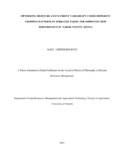Optimizing moisture and nutrient variability under different cropping patterns in terraced farms for improved crop performance in Narok county, Kenya
Abstract
Terraces have been used to regulate, discharge excess runoff and reduce soil loss, however its ability to harvest and store water in the terraced field has not been fully investigated. A field experiment was therefore carried out in Suswa, Narok County during the short and long rain seasons of 2013-2015 to assess the variabilityof soil moisture and nutrients in terraced field and the effect it has on crop performance under different cropping patterns with a view of developing an appropriate cropping pattern that will maximally utilize the harvested water and the accumulated nutrients for promotion for adoption by farmers in drylands where low soil moisture and nutrients are a challenge. A randomized complete block design was used with maize and beans as the test crops. The treatments were; CP1: Maize and Bean intercrop in the upper and lower terrace position and sole maize in the middle, CP2: Maize and Bean intercrop in the upper and lower terrace position and sole bean crop in the middle, CP3: Sole maize crop in all the three terrace slope position, CP4: (control) where terrace was not maintained and CP5: had intercrop of maize and beans in all slope positions. Observations were made on soil moisture, pH, N, P, K and C, uptake of N, P, K by maize and plant growth including height, number of leaves, leaf area index (LAI), grain and biomass yields at different slope position during the four seasons. Gross margin analysis was done to evaluate the profitability of maize and beans production per cropping pattern and slope position. The results indicated that the lower terrace position had the highest moisture content at 30, 50 and 75 cm depths in all seasons, however CP3 had the highest soil moisture (19.91%) while CP4 had the least (14.1%) at 50 cm depth in season I (August to December, 2013). N, P and C were significantly (p<0.05) affected by slope position with the highest values recorded at the lower slope position, resulting in improved nutrient uptake in both maize above ground biomass and grain. The middle slope position had the least P uptake (1125 ppm) compared to the lower position (1703 ppm) in season IV (January to May, 2015). The lower slope positions had the highest K uptake while the upper positions had the least in all seasons. On average grain uptake of N in the four seasons was 1.53% in the lower and 1.26% in the upper slope positions. The same trend was observed in nutrient uptake by maize grain. There were significant differences (p≤0.05) in growth parameters; height, LAI and number of leaves as affected by slope position and treatments in all seasons. These parameters were found to be highest in the lower slope position compared to the upper position. Similarly CP4 recorded the least crop performance. There were significant differences (p≤0.05) in maize and bean grain yields at different slope positions and treatments in all seasons. CP1, CP2 and CP5 had on average the highest (above1000 kgha-1) bean grain yields whereas CP4 had the lowest (670 kgha-1). CP1, CP2, CP3 and CP5 recorded the highest (6.8) maize grain yields whereas CP4 had the lowest (3.5 tha-1) in season I (August to December, 2013) and III (August to December, 2014). The lower slope position had the highest (6.23 tha-1) maize grain yields compared to the upper slope position (below2 tha-1) in all seasons. Likewise the highest gross margins (196,331; 100,265) were realized in the lower slope position with the upper position recording the least (51,881; 4,745) for maize and beans respectively. CP4 (control) had the least gross margins for both crops. There was no significant difference in yields and gross margins of sole maize crop and intercrops in all seasons. CP 3 (sole maize) had comparable (120,551) gross margins with intercrops, CP1 (117,986) and CP2 (118,526), meaning that the farmer can get more value for land, time and labour by intercropping. The study found that CP2 (Maize and Bean intercrop in the upper and lower terrace position and sole bean crop in the middle) was the most favourable for the study area. The investigation concluded that terracing had effect on productivity and farmers can benefit from the spatial nutrient and moisture variability as a low technology precision farming for increased yields.
Publisher
University of Nairobi

